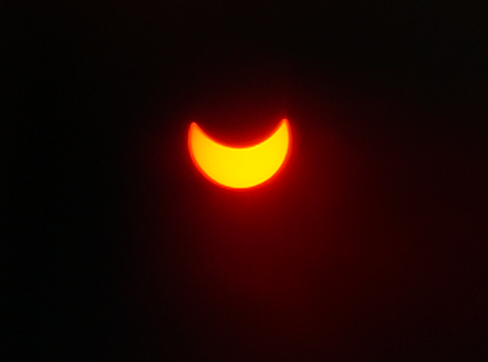Total Solar Eclipse

Solar eclipse 20 march 2015, photo made in east of Moscow, 10:35 UTC. Photo was token through the Diskette. Author: 1stJake carter. Source: Wikimedia Commons.
The New Moon of Monday, August 21 casts its shadow onto the Earth, causing a total solar eclipse! And this time, the Moon casts its shadow across the USA, allowing Americans to join in the experience much more easily than in recent memory. (The last total eclipse visible form the contiguous US states occurred in February 1979).
A map of the Moon’s shadow’s path is here:
http://xjubier.free.fr/en/site_pages/solar_eclipses/TSE_2017_GoogleMapFull.html
Anyone in that path can see up to 2 minutes, 40 seconds of totality. Everyone inside the green boundary lines on that site, including everyone in North America, is close enough to the shadow to see a partial eclipse. Here in Houston, the Moon blocks a portion of the sun from 11:46 am to 2:45 pm, covering about 2/3 of the Sun’s disk at 1:16 pm. We have invited volunteers to share this event with the public at both of our campuses, in Hermann Park and in Sugar Land. Also, at 12:00, 12:20, 12:40, 1:00, 1:20, and 1:40 on the 21st, the Burke Baker Planetarium will offer short special programs about the eclipse in progress. Then at 2, the Starry Night Express show features a live feed from Casper, Wyoming, with our staff in the path of totality.
Of course, we can’t see the eclipse if we can’t see the Sun. However, our planetarium shows cannot be clouded out. If you can’t travel to totality, come join us!
Your August 2017 Map To The Stars!

This star map shows the Houston sky at 10 pm CDT on August 1, 9 pm CDT on August 15, and dusk on August 31. To use the map, put the direction you are facing at the bottom.
The Summer Triangle is high overhead. This consists of the brightest stars in Cygnus, Lyra, and Aquila. Scorpius, the Scorpion, is in the south, with the ‘teapot’ of Sagittarius to his left. From the Big Dipper’s handle, ‘arc to Arcturus’ and ‘speed on to Spica’ in the southwest. Saturn is in Ophiuchus, between Scorpius and Sagittarius in the south at dusk. The Great Square of Pegasus rises in
What Our Celestial Neighbors Are Up To This Month:
Jupiter is now lower in the west southwest. Face southwest at sundown to see the King of Planets. Only the Sun, the Moon, and Venus outshine Jupiter.
Saturn is well placed for evening viewing, due south to the left of reddish Antares at dusk. Saturn won’t be nearly as bright as Jupiter, but easily outshines the stars right near it.
Venus remains a brilliant morning star this month. Look in the east at dawn. Venus outshines everything in the sky except the Sun and the Moon.
Mars is lost in the Sun’s glare and out of sight all summer.
The annual Perseid Meteor Shower peaks every year in mid-August—this year on August 12. Remember that this is a shower, not a storm; you can expect a meteor per minute on average. Also, Earth is actually running into the meteor stream, rather than the meteors running into us. This means that the shower gets better as you get closer to dawn. Our George Observatory will be open late Saturday night, August 12, until 2:00 am Sunday, August 13, for viewing the Perseids.
Moon Phases in August 2017:
Full Aug. 7, 1:11 p.m. Last Quarter Aug. 14, 8:15 p.m.
New Aug. 21, 1:30 p.m. 1st Quarter Aug. 29, 3:13 a.m.
The Full Moon of August 7 skirts the upper part of the Earth’s shadow, causing a partial eclipse of the Moon visible in Europe, Asia, and Africa. Have you noticed that eclipses occur in ‘seasons’ about six months apart, and that we have either a good solar eclipse at New Moon or a good lunar eclipse at Full Moon, but not both? That’s because the Moon’s orbit is inclined by five degrees to Earth’s orbit around the Sun. To produce an eclipse, the Moon must align exactly with the Earth and Sun; it must be passing through the plane that contains Earth and Sun right at New Moon (for a solar eclipse) or Full Moon (for a lunar eclipse). The motion of the Earth/Moon system makes this alignment good for a short time only. If the alignment at New Moon is good enough to cause a solar eclipse, it won’t be good enough two weeks later at Full Moon to cause a lunar eclipse. Conversely, in 2014-2015 when we had those four ‘blood moons’, the good alignments at Full Moon meant that the New Moons two weeks later were not aligned well enough to cause good solar eclipses.
On most clear Saturday nights at the George Observatory, you can hear me do live star tours on the observation deck with a green laser pointer. If you’re there, listen for my announcement.
Clear Skies!








